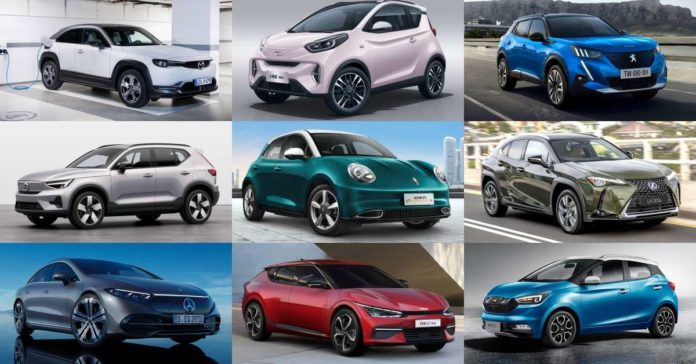In October last year, finance minister Tengku Zafrul Aziz announced during his Budget 2022 speech that the government was set to introduce tax breaks for electric vehicles (EVs) in Malaysia. The move, planned for introduction on January 1 this year, involves offering 100% exemption of import and excise duties as well as zero road tax for CBU electric cars up to December 31, 2023, and 100% duty exemption for CKD electric cars up to December 31 December, 2025.
January has of course come, and there is still very little in the way of actual announcements being made by companies (or the government, for that matter) with regards to this topic, especially for cars that have already been announced or introduced for the market.
UPDATE: (April 2022) Since the story was posted, prices have been updated for the BMW iX, iX3 and iX4 as well as the Porsche Taycan and Taycan Cross Turismo range and the Volvo XC40 Recharge Pure Electric P8 (now launched). The Mercedes-Benz EQA and Hyundai Ioniq 5 (both launched) have been added, and the indicative price of the Mazda MX-30 has now been included.
Obviously, revisions are hardly likely to apply for long-entrenched models such as the Nissan Leaf, where there is existing stock (with taxes already paid for them), but new, incoming models such as the Hyundai Kona, for example, should have their indicative prices firmed up to definitive ones (with all tax exemptions in place), if application of the proposed tax incentives have already started, that is. Curiously, at time of writing, the only price revision that was noted for an existing, on-sale model was that for the MINI Cooper SE, which is now RM35k cheaper than before.
Barring any major delays in the full implementation of the tax exemption scheme, we can expect to see electrification pick up significantly in Malaysia this year. Quite a few cars have been announced as being due for this market, and so, here’s a quick sampling of what’s already available and what’s expected to come our way this year (and into 2023) on the battery electric vehicle front. Unless indicated otherwise, existing prices are with taxes applied and not with incentives in place.
BMW iX – on sale, from RM361,430 to RM407,430 (prices revised, January 2022)
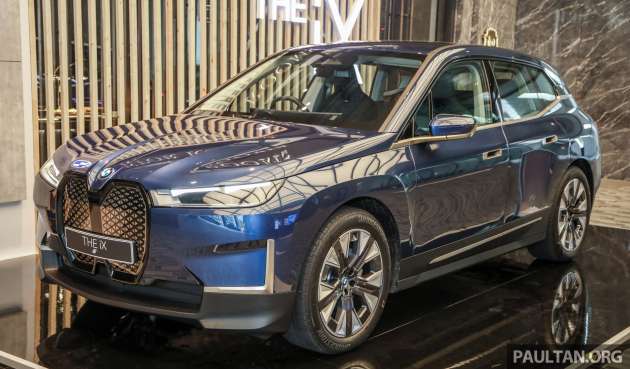
UPDATE: (January 2022) The price of the BMW iX has been updated in the story following the reveal of BMW Malaysia’s new 2022 price list for the car.
When it was launched in Malaysia last August, prices for the BMW iX began from RM419,630 for the xDrive40 and RM472,630 for the xDrive40 Sport, the latter consisting of a RM53,000 add-on package to the base car. Now, new tax exemption prices have finally been announced – as of January 13, the X5-sized flagship EV is priced at RM361,430 for the xDrive 40 and RM407,430 for the xDrive40 Sport, making them RM58,200 and RM65,200 cheaper than last year, respectively.
In its xDrive40 guise, the iX features two electric motors offering 326 PS (322 hp or 240 kW) and 630 Nm, which is good for a 0-100 km/h time of 6.1 seconds and a 200 km/h top speed. A 76.6 kWh battery provides up to 425 km of range (WLTP cycle), and with AC charging (11 kW, Type 2) it takes seven hours and 15 minutes to get the battery to full. Going with DC charging (up to 150 kW) allows a 10-80% state of charge to be done in about 31 minutes.
BMW iX3 – on sale, from RM307,160 to RM325,160 ((prices revised, January 2022)
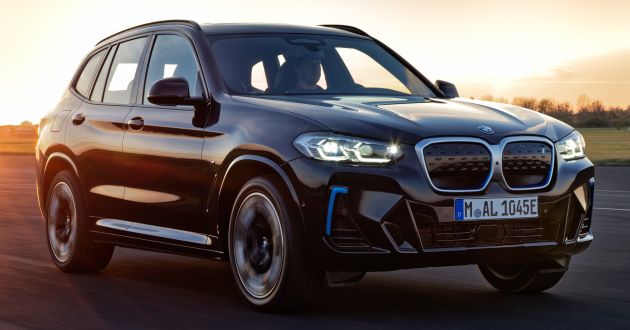
UPDATE: (January 2022) The price of the BMW iX3 has been updated in the story following the reveal of BMW Malaysia’s 2022 price list for the car.
Launched here in October last year, the G08 BMW iX3 is based on the regular X3 SUV, but equipped with an electric powertrain. It’s available in two variants, Inspiring and Impressive, priced at RM317,360 and RM336,360 respectively when the SUV was announced last year. Now, the price for 2022 has been revealed, and it’s RM307,160 for the Inspiring and RM325,160 for the Impressive, a drop of RM10,200 and RM11,200 respectively.
Both variants are identical mechanically, powered by a rear-mounted electric motor delivering 286 PS (282 hp or 210 kW) and 400 Nm of torque. Performance-wise, the SUV gets from zero to 100 km/h in 6.8 seconds and has an electronically-limited top speed of 180 km/h. A 73.8 kWh battery provides up to 453 km of range (WLTP cycle), and via AC charging (11 kW) it takes around 7.5 hours to get the battery to full. With DC charging (up to 150 kW), the battery can be filled to 80% in just 32 minutes.
BMW i4 eDrive40 – on sale, RM389,900 (presently from RM364,676 with SST exemption until June 30, 2022)
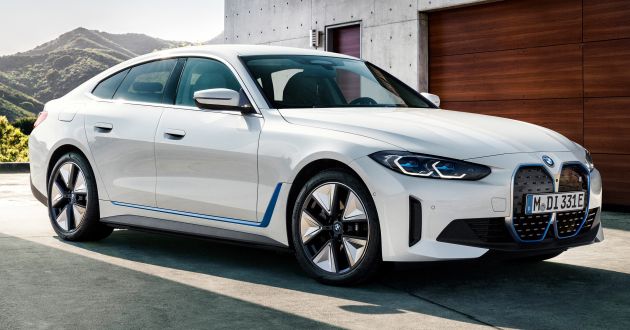
UPDATE: (April 2022) The price of the BMW i4 eDrive40 was officially announced on April 7, but the car is currently priced with SST exemption until June 30, 2022.
Having first appeared on its website in May, BMW Malaysia confirmed in August that it would be introducing the fully electric i4 here, and although it has yet to officially do so, the model should make an entry into our market this year. The four-door gran coupe will arrive as an eDrive40 variant.
In this guise, the car’s electric motor delivers 340 PS (335 hp or 250 kW) and 430 Nm of torque to the rear wheels via a single-speed transmission, allowing it to do the 0-100 km/h run in 5.7 seconds and an electronically-limited top speed of 190 km/h. An 83.9 kWh battery provides up to 590 km of range (WLTP cycle), and AC charging (at 11 kW, Type 2) gets the battery to full in under 8.5 hours. It supports up to 200 kW DC fast-charging, so a 10-minute charge can provide up to 164 km of range.
Changan Eado EV460 – CKD plans in store, eventual assembly in Melaka

Earlier this week, Fieldman EV revealed plans to invest RM1 billion in an assembly plant in Elkay Lipat Kajang Industrial Area in Jasin, Melaka, where it is set to assemble Changan vehicles for Malaysia as well as the Southeast Asian regional market. While no direct mention was made as to which models would go the CKD route, the line-up could include the Eado EV460, an example of which was presented to the state government.
The sedan features a front electric motor rated at 136 PS (134 hp, or 100 kW) and 245 Nm, and a 52.56 kWh battery provides up to 430 km or 460 km of travel range (NEDC cycle), depending on road conditions. Normal AC charging takes eight hours to get the battery to full, while DC fast charging can get the battery to an 80% state of charge (SoC) from zero in about 50 minutes.
Chery eQ1 – possible introduction when brand returns to Malaysia this year
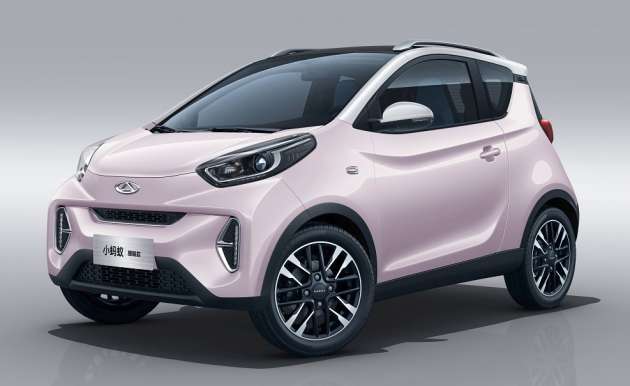
Chinese carmaker Chery is set to return to Malaysia this year, and while it will concentrate its initial focus on regular ICE SUVs, it also said it is hoping to tap into the avenue of electrification with its little eQ1, which it said could possibly make its way in as early as this year.
The two-door, four-seater, is a higher output available in two range option variants, the first being a 301 km version equipped with a 30.6 kWh lithium battery, and the second a 408 km version with what should be an uprated 38 kWh battery, both ranges quoted under a NEDC cycle. For the 74 hp (55 kW) version, performance figures include a 0-50 km/h acceleration time of under five seconds and a top speed of 120 km/h.
Great Wall Motors Ora Good Cat – expected sometime in Q1 this year
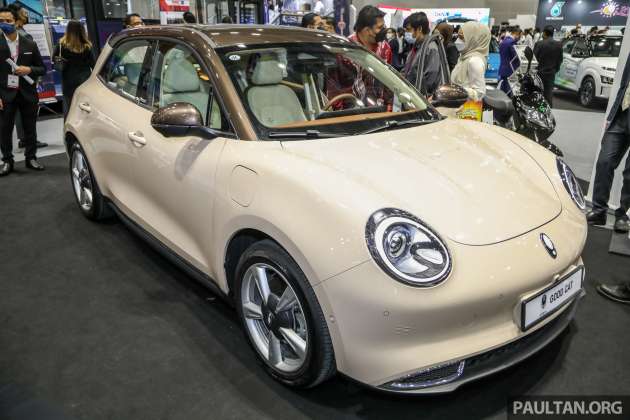
Previewed last month, the Ora Good Cat is expected to be introduced here by Go Auto early this year, pending government approval. While the evaluation unit on show was a LHD example, quoted specifications for the local model, when it arrives, will be identical to the top-spec Ultra that is sold in Thailand at a price of 1.199 million baht (RM149,857).
A front electric motor rated at 143 PS (141 hp or 105 kW) and 210 Nm of torque offers the car a 0-100 km/h time of 7.6 seconds and a 152 km/h top speed. Juice is provided by a 63.1 kWh ternary lithium battery, which offers 501 km of range. As for charging, AC charging up to 6.6 kW gets the battery to full in about ten hours, while DC charging (up to 60 kW) will get it to 80% state of charge in around an hour.
Hyundai Ioniq 5 – on sale, from RM199,888 to RM259,888

The Ioniq 5 is the second all-electric model to be launched by Hyundai-Sime Darby Motors in the country. The 2022 World Car of the Year is available in three variant forms here, namely Lite (RM199,888), Plus (RM229,888) and Max (RM259,888). The Lite comes with the 58 kWh lithium ion polymer battery and rear-wheel drive, and the Plus is a higher-spec version of the 58 kWh RWD car. The Max is the range-topper with a 72.6 kWh battery and dual-motor AWD.
The Lite and Plus feature a 170 PS (125 kW) and 350 Nm rear motor, while the dual-motor AWD has a combined 305 PS (225 kW) and 605 Nm output. The RWD variants manage the 0-100 km/h run in 8.5 seconds, while the AWD whittles it down to 5.2 seconds. Top speed is 185 km/h for all variants.
Listed WLTP range on a full charge is 384 km for the 58 kWh car and 430 km for the 72.6 kWh AWD. As for charging, juicing up with a 11 kW home AC charger takes five hours for the 58 kWh and slightly more than six hours for the bigger battery, while DC charging at 50 kW will replenish the battery from 10% to 80% in 47 minutes. The Ioniq 5 supports chargers of up to 350 kW, which brings the charge time down to just 18 minutes.
Hyundai Kona Electric – on sale, from RM149,888 to RM199,888
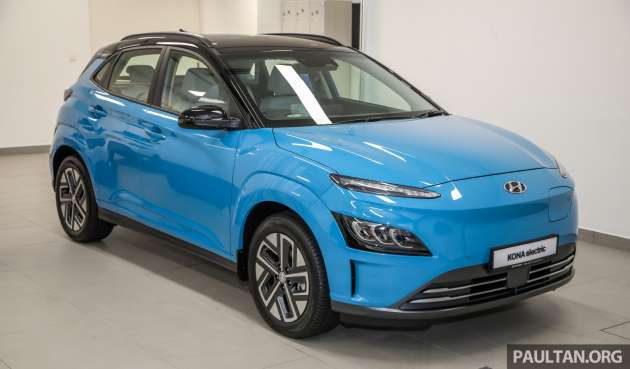
Officially introduced last November, the Kona Electric is presently on sale in Malaysia in three variant forms, a base 39.2 kWh model called the e-Lite (RM149,888), a higher-specification 39.2 kWh version called the e-Plus (RM169,888) and a range-topping 64 kWh unit known as the e-Max (RM199,888). At point of launch, the prices were inclusive of the import and excise duty exemptions being factored in, and remain unchanged at this juncture.
The 39.2 kWh variants feature a 136 PS and 395 Nm motor, and have an operating range of 305 km on a single charge (WLTP cycle). Performance figures include a 0-100 km/h sprint time of 9.9 seconds and a 155 km/h top speed. The 64 kWh model ups output to 204 PS, and range increases to 484 km. The variant does the 0-100 km/h run in 7.9 seconds and has a 167 km/h top speed.
iIn terms of AC charging, the base e-Lite has a 7.2 kW onboard charger, and it takes around 6.5 hours to get the battery from 10% to 80% SOC. The e-Plus 39.2 kWh and Max 64 kWh variants have a 11 kW onboard charger, and it takes 4.5 hours for the 39.2 kWh and around 7.5 hours for the 64 kWh with the AC route. With DC fast charging (at 50 kW), it takes 60 minutes for the 39.2 kWh model and 90 minutes for the 64 kWh version to juice up.
Jaguar I-Pace – likely to be launched sometime this year
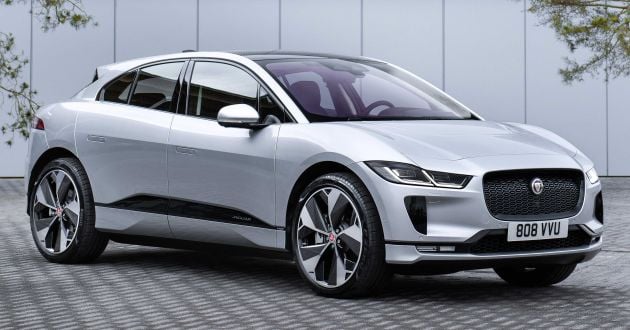
In October last year, Jaguar Land Rover Malaysia indicated plans to introduce the fully-electric Jaguar I-Pace here. Although no specific timeframe was indicated beyond it making its way here “in the near future,” it’s very likely to be on the cards for 2022.
The I-Pace packs a dual-motor powertrain with 400 PS (394 hp) and 696 Nm of torque on tap, which allows the SUV to do the 0-100 km/h sprint in just 4.8 seconds. A 90 kW battery pack offers 480 km of travel range (WLTP), and its 11 kW onboard charger allows a full charge with a 11 kW wallbox in 8.6 hours, or 12.75 hours with a 7 kW wallbox. Meanwhile, DC fast charging at up to 100 kW will replenish the battery at a rate of 125 km of range in 15 minutes.
Kia EV6 – to be launched sometime in Q3/Q4 this year

According to analyst reports, the EV6 – which is the Korean automaker’s first electric vehicle – is slated to be introduced in Malaysia this year, arriving here in fully-imported form sometime in either the third or fourth quarter.
Powertrain options include rear- and all-wheel drive setups for both standard-range 58 kWh and long-range 77.4 kWh battery versions, with outputs ranging from 170 PS (167 hp or 125 kW) and 350 Nm for the 58 kWh/RWD to all the way up to 585 PS (577 hp or 430 kW) and 740 Nm for the 77.4 kWh/AWD EV6 GT variant. As for operating range, it starts from 394 km for the base 58 kWh/RWD, increasing to 528 km for the 77.4 kWh/RWD variant. It remains to be seen how many variants will go on sale here.
Kia Niro EV – planned for introduction, possibly sometime in Q4
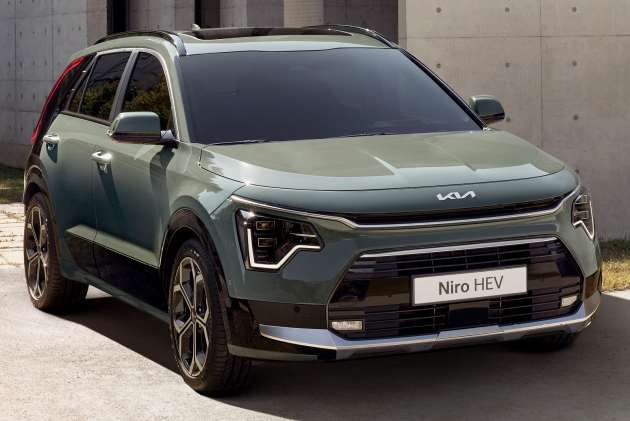
The EV6 won’t be the only Kia electric model coming our way, as Bermaz Auto has indicated plans to introduce both plug-in hybrid and fully-electric versions of the Niro, reportedly sometime in the fourth quarter, according to an investor report.
The automaker hasn’t released technical details of the new second-generation model, so it remains to be seen if there will be any changes to the powertrain and specifications from that of the existing model, which shares the same 39.2 kWh and 64 kWh battery configurations as the Hyundai Kona. Likewise, the motors, with 136 PS (134 hp or 100 kW) and 204 PS (201 hp or 150 kW) variations on call, both with identical 395 Nm of torque.
Lexus UX 300e – planned for introduction this year
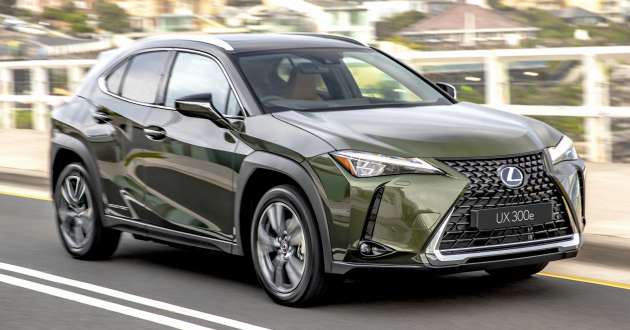
The UX 300e is slated to make its way to Malaysia this year in a bid to take advantage of the tax breaks, so we’ve been told by internal sources. No indication of pricing, but with the exemptions, it’s expected that the SUV – which is the sole EV offering at present in the Japanese automaker’s model line-up – will dip under RM300k in terms of pricing.
Powered by a single, front-mounted electric motor producing 204 PS (201 hp) and 300 Nm of torque, performance figures include a 0-100 km/h time of 7.5 seconds and a 160 km/h top speed, while operating range on a full charge is 300 km, based on a WLTP cycle. The 54.3 kWh battery can be charged in around five to six hours via AC charging at a rate of 6.6 kW from a wallbox, while DC fast charging (up to 50 kW, CHAdeMO) from zero to a 80% SOC takes about 50 minutes.
Mazda MX-30 Electric – to be launched sometime in Q3/Q4 this year, est under RM200,000
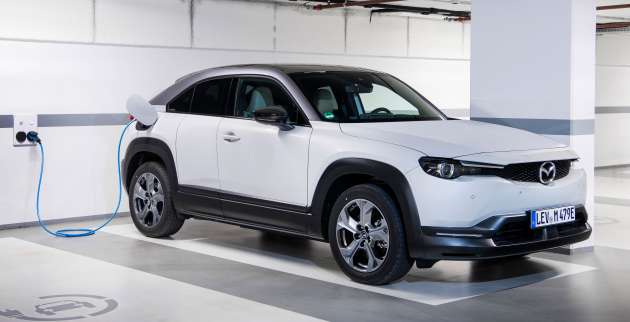
UPDATE: (April 2022) Bermaz Motor, the official distributor of Mazda vehicles in Malaysia, has previewed the MX-30 in the country ahead of a Q4 introduction, and indicative pricing for the EV is that it is expected to be under RM200k.
The Mazda MX-30 Electric is expected to be introduced in Malaysia sometime in the third or fourth quarter of this year, with an evaluator already sighted on local roads. While there has been no indication of pricing, a comparison of UK pricing of the MX-30 and the Hyundai Kona Electric provides a working estimate that the MX-30 could roll in at under RM150k.
The electric crossover features a 145 PS and 271 Nm electric motor, which drives the front wheels via a single speed reduction gear. Juice for the e-motor is provided by a 35.5 kWh lithium-ion battery, offering the car up to 199 km of travel range. With AC charging (up to 6.6 kW) via its Type 2 port, it takes about three hours to get the battery from 20% to 80%, while DC charging (up to 50 kW) requires just 36 minutes.
Mercedes-Benz EQA 250 AMG Line – on sale, RM278,201
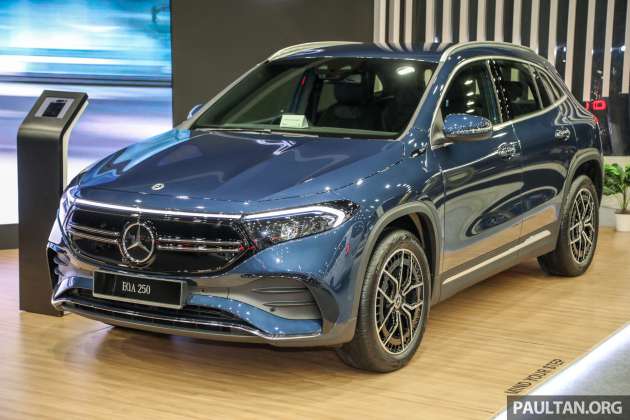
Mercedes-Benz Malaysia’s first all-electric offering is the EQA, which made its local debut in March. The compact SUV goes on sale here in as an EQA 250 AMG Line variant, fully-imported from Germany. It’s powered by a single asynchronous electric motor that drives the front wheels through a single-speed gearbox. The 190 PS (188 hp or 140 kW) and 375 Nm on call offers the vehicle a 0-100 km/h time of 8.9 seconds and a top speed of 160 km/h.
Its 66.5 kWh lithium-ion battery can be recharged fully in five hours and 45 minutes using the vehicle’s 11-kW onboard AC charger (Type 2 connection). Alternatively, DC fast charging up to 100 kW and a CCS2 connection will get the battery from a 10-80% state of charge (SoC) in just 32 minutes. A fully charged battery offers the EQA up to 429 km of travel range (WLTP cycle).
Mercedes-Benz EQS – finally coming this year?
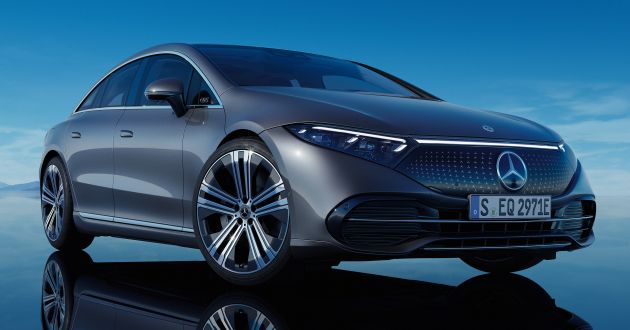
Mercedes-Benz Malaysia’s EV push will include the EQS, which has been in the pipeline for a while now. The EQE is also likely to be another highlight, but whether or not it will be in 2022 remains to be seen.
The automaker’s flagship EV sedan is currently available in two regular forms, a rear-wheel drive EQS 450+ with 333 PS (329 hp or 245 kW) and 568 Nm, and an all-wheel drive EQS 580 4Matic with 523 PS (516 hp or 385 kW) and 855 Nm. There’s also a Mercedes-AMG EQS 53 4Matic+, which has 761 PS (751 hp or 560 kW) and 1,020 Nm with an optional AMG Dynamic Plus package strapped on.
Claimed operating range is 770 km for the EQS 450+ and 676 km for the EQS 580, while the EQS 53 can achieve 580 km on a single charge (all WLTP cycle). There are two battery sizes, 90 kWh and 107.8 kWh – both are available for the EQS 450+, while the EQS 580 and EQS 53 feature only the 107.8 kWh unit. As standard, the car has an 11 kW onboard AC charger, but a 22 kW unit can be specified. The EQS is also compatible with up to 200 kW of DC fast charging, which can provide up to an additional 300 km of range in just 15 minutes.
MG ZS – no introduction plans at present, but negotiations reportedly ongoing with new party

First sighted in 2020, and spotted again recently (albeit wrapped in camo), the MG ZS was originally scheduled to be marketed and sold by MG Berjaya. At present, it’s a non-starter as the deal between Berjaya and China’s SAIC fell through a good while ago. It has however been included in this list as we were told late last year that another party has been negotiating a deal to bring the electric SUV – which is sold in Thailand – in. It might happen, it might not.
The ZS EV is powered by a 150 PS and 350 Nm electric motor, with a 44.5 kWh lithium-ion battery offering the car a quoted operating range of 335 km (on an NEDC cycle). With a MG Home Charger, AC charging (at 6.6 kW, Type 2) gets the battery to full in around 6.5 hours, while DC charging will get the battery to 80% SOC in 30 minutes.
MINI Cooper SE facelift – on sale, RM178,241 (price revised, effective January 1, 2022)
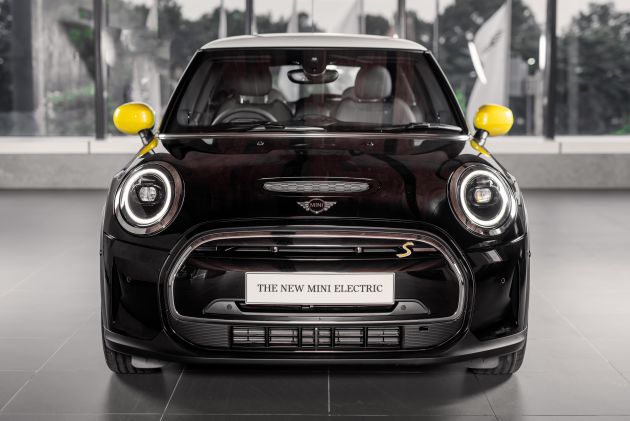
The electric Cooper has been around for a while – the car made its Malaysian debut in 2020, and the facelift arrived last year, priced at RM213,461 (with the standard two-year warranty). Now, a new price list on the MINI Malaysia website indicates the price has dropped, likely as a result of EV tax exemption being incorporated, although it’s not known if this is already in effect at retail level – as of January 1, 2022, the Cooper SE is priced at RM178,241 (inclusive of SST exemption, standard two-year warranty), a RM35,220 reduction from before.
The Cooper SE is powered by a front-mounted electric motor producing 184 PS (181 hp or 135 kW) and 270 Nm, which gets the car from 0-100 km/h in 7.3 seconds and to a 150 km/h top speed. A 28.9 kWh battery delivers a range of up to 232 km on the WLTP cycle, and AC charging at 11 kW gets the battery to full in around two and a half hours. With DC fast charging (up to 50 kW) via its CCS socket, the battery can get from 10 to 80% in just 36 minutes.
Nissan Leaf – on sale, RM181,263 (without EV tax exemption)

The Nissan Leaf was one of the first electric vehicles to be introduced here, with the first gen making its debut here in 2013. The current second-generation model was introduced in 2019, and its pre-tax exempted price last year was RM181,263, the price of which remains, since the cars were brought in prior to exemptions being announced.
It’s powered by a 150 PS (110 kW) and 320 Nm motor, which offers the car a 0-100 km/h time of 7.9 seconds and an electronically-limited top speed of 155 km/h. A 40 kWh battery provides 270 km of range (WLTP), and AC charging (Type 1, 6.6 kW) takes about seven hours to full, while DC (CHAdeMo, up to 50 kW) gets it juiced up in about an hour. The Leaf is presently available for short-term use and long-term lease within the Klang Valley, via GoCar’s GoEV car sharing programme.
Opel Vivaro-e – an indicator that the Zafira-e Life could be on the way in?
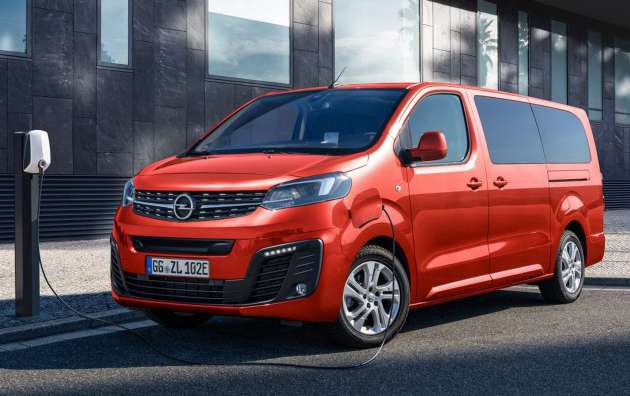
Yes, it’s technically a commercial entity, the Opel Vivaro-e that was spotted twice recently, but its very presence – and mention that “a new brand is coming in” – highlights the possibility of the brand’s return to Malaysia, which would pave the way for something like the Zafira-e Life, the passenger version of the electric van (seen in these photos), to come our way. Hence, its inclusion here, if only as conjecture.
Both the Vivaro-e and Zafira-e Life share a common powertrain, in this case a 136 PS (134 hp or 100 kW) and 260 Nm electric motor, and both are available in two battery capacity configurations, these being a 50 kWh with up to 200 km of range and a 75 kWh unit with up to 300 km of range (WLTP cycle). The electric Zafira is available in three length sizes and five, six, seven or eight-seat configurations, and would certainly make for an interesting alternative in the segment.
Peugeot e-2008 – to be launched in Q4 this year

The Peugeot e-2008 is set to be one of three new models from the French brand that will be introduced here this year by new distributor Bermaz. The electric B-segment SUV is scheduled to make its local debut sometime in the final quarter.
Equipped with a 136 PS (134 hp or 100 kW) and 260 Nm motor that’s fed by a 50 kWh lithium-ion battery, the e-2008 can travel up to 345 km (WLTP cycle) on a single charge. The AC charging times are 16 hours via a domestic 230-volt socket, eight hours through a 7.4 kW single-phase wallbox, and five hours and 15 minutes with a 11 kW three-phase wallbox. Up to 100 kW DC fast charging is supported, and it takes 30 minutes to get the battery to 80% SOC.
Porsche Taycan – on sale, from RM508,000 to RM934,000 (prices revised, January 2022)
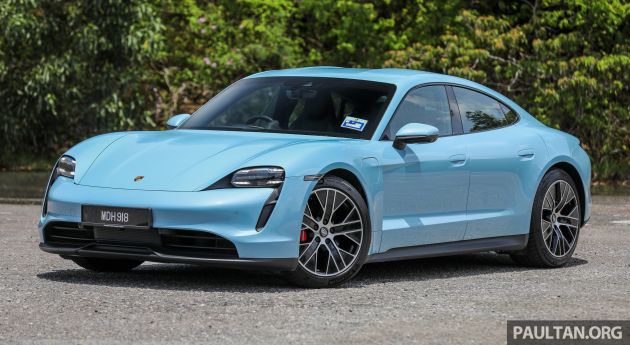
UPDATE: The price of the Porsche Taycan range has been updated to that of the new tax-free prices announced on January 17.
Launched here in September 2020, the Taycan is currently available in four variant forms, these being a base RWD model (priced from RM584,561), the Taycan 4S (RM699,986), Taycan Turbo (RM963,297) and the Taycan Turbo S (RM1,151,779). At some point later this year, the line-up will add on the Taycan GTS, which doesn’t have a price because it’s not on sale yet. The above prices are from 2021, so it’s expected that they will go down when the exemptions eventually come into play.
Two battery configurations are available for the base RWD and Taycan S, a standard single-deck 79.2 kWh Performance Battery and an optional two-deck 93.4 kWh Performance Battery Plus. On the base car, these offer up to 431 km and 484 km of travel respectively, while on the Taycan 4S they are 408 km and 464 km. The Turbo and Turbo S are fitted with the 93.4 kWh unit as standard, and up to 452 km and 408 km of travel range is available respectively, all based on WLTP cycles.
Charging with AC (11 kW) takes 8.0 hours for the 79.2 kWh and 9.0 hours for the 93.4 kWh to get to full, while DC (50 kW) takes slightly more than 1.5 hours to get the battery to an 80% state of charge from 5%. Meanwhile, power outputs range from 326 PS (322 hp or 240 kW) for the base RWD all the way up to 625 PS (617 hp or 460 kW) for the Turbo and Turbo S.
Porsche Taycan Cross Turismo – on sale, from RM555,000 to RM798,000 (prices revised, January 2022)

UPDATE: The price of the Porsche Taycan Cross Turismo range has been updated to that of the new tax-free prices announced on January 17.
Launched in Malaysia last October, the Taycan Cross Turismo is essentially a more rugged version of the regular Taycan, and offers greater space – and practicality – thanks to its wagon body style. Three variants are available locally, the base model starts from RM555,000 (just over RM90,000 cheaper), while the 4S goes for RM617,000 (RM111,727 less). The most powerful Cross Turismo, the Turbo, is yours for RM798,000, or nearly RM171,000 cheaper than before.
All three are dual-motor, all-wheel drive versions, equipped with a two-deck 93.4 kWh Performance Battery Plus unit. Charging times are thus similar to the Taycan with the same battery, at 9.0 hours via AC charging (11 kW, faster if the optional 22 kW onboard charger is specified). There’s also support for DC fast charging (up to 270 kW), which can bring the battery from a 5% to 80% state of charge in around 23 minutes at that rate.
Travel range is up to 456 km for the base model and up to 452 km for the 4S version (WLTP cycle), and power outputs range from 380 PS (375 hp or 280 kW) or 476 PS (469 hp or 350 kW) and 500 Nm of torque with overboost for the base Cross Turismo to 625 PS (617 hp and 460 kW) or 680 PS (670 hp or 500 kW) and 850 Nm with overboost for the range-topping Turbo.
Seiyong S1 – announced last March, no indication of market launch date as yet
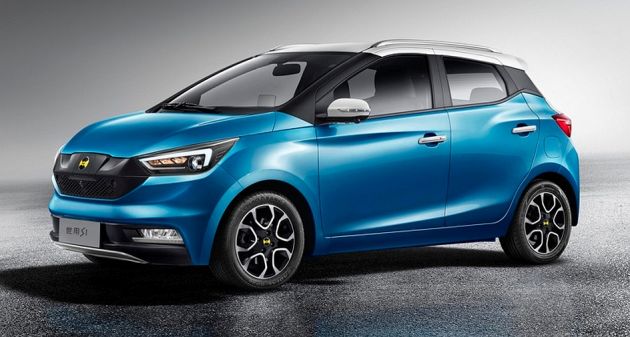
In March last year, Ho Wah Genting revealed it plans to introduce the Seiyong S1, with local assembly reportedly on the cards. While little has been heard of about it since then, the project might surface again this year.
Targeted as a city commuter, the S1 is powered by a 35 kw (47 hp) and 150 Nm electric motor, which offers the car a 110 km/h top speed. A 31.9 kWh lithium battery provides a claimed range of 302 km on a single charge, based on a NEDC cycle. The battery can be juiced up from a 30% SOC to 80% in around 40-50 minutes via fast charging, or around 10 hours with regular charging.
Tesla Model 3 – on sale, from RM323,928 to RM453,528 (indicative, with tax exemptions)
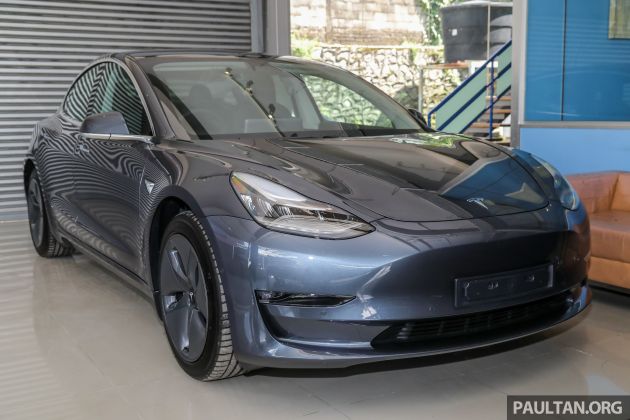
In December, the Malay Vehicle Importers and Traders Association of Malaysia (PEKEMA) announced that Tesla models would be available on a much wider basis than previously, importing them directly via its network.
The cheapest of these is the Model 3, priced from RM323,928 for a single-motor rear-wheel drive version. The car is also available in dual-motor Long Range (from RM370,728) and Performance (from RM453,528) forms, all coming in from the UK. With batteries ranging from 54 kWh to 82 kWh, travel range is anywhere from 448 km to 567 km, based on WLTP cycles.
Tesla Model S – on sale, from RM712,656 to RM878,256 (indicative, with tax exemption)
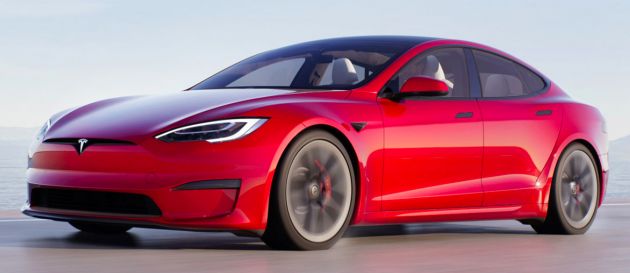
As for the Model S facelift, buyers have two models to pick from, with prices starting from RM712,656 for a Basic (essentially, the Long Range), going up to RM878,256 for an S Plaid. As with all the other Tesla vehicles sold via this route by PEKEMA, the cars are new units, imported from the UK.
The base version, which offers a claimed range of 652 km on a single charge (WLTP cycle), does the 0-60 mph (0-96 km/h) dash in 3.1 seconds and manages a 250 km/h top speed. The Plaid variant with the tri-motor configuration can do a maximum of 628 km (again, WLTP) on a full charge. As it is with the X Plaid, output is rated at 1,033 PS (1,020 hp or 760 kW), which gives the S Plaid a 0-96 km/h time of just under two seconds.
Tesla Model X – on sale, from RM817,128 to RM950,328 (indicative, with tax exemption)
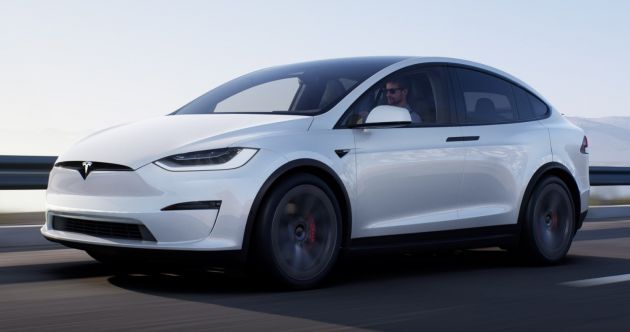
Two choices again for the Model X facalift, these being a Basic, for which prices start from RM817,128, and the X Plaid, which is priced from RM950,328.
The base X is a dual-motor AWD version, which offers 580 km in the way of range, but all the attention will certainly be on the Plaid, which has three motors and 1,033 PS (1,020 hp or 760 kW) on call. That’s enough for it to do the 0-96 km/h sprint in 2.5 seconds and hit 262 km/h. Its 100 kWh battery provides up to 547 km of WLTP range on a full charge.
Tesla Model Y – on sale, from RM417,528 to RM489,528 (indicative, with tax exemption)

PEKEMA is offering two versions of the seven-seater Model Y, which was unveiled back in March 2019. These are the Long Range, which is priced from RM417,528, and the Performance, which starts from RM489,528, both imported new via the UK route.
The Long Range is the dual-motor all-wheel drive variant (Tesla has dropped the Long Range RWD version), and with 351 PS (346 hp or 258 kW) and 527 Nm, the car is able to do the 0-96 km/run in 4.8 seconds on the way to a 217 km/h top speed. The Performance is also AWD, and with 462 PS (456 hp or 340 kW) and 639 Nm, is able to cover the same sprint in 3.5 seconds and get to 241 km/h. As for range, drivers will get up to 505 km of range on the LR AWD and 480 km on the Performance (WLTP cycle).
Toyota bZ4X – coming our way in 2023
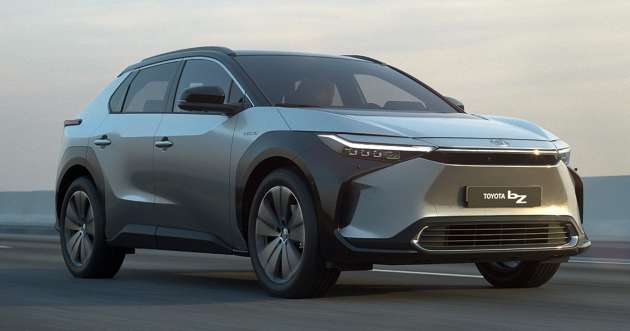
The first model in Toyota’s bZ electric vehicle series, the bZ4X, is set for Malaysia, so we’ve been told, but it’s not coming in that soon – word is that the sharp-looking crossover (which has its twin in the Subaru Solterra) is only slated to arrive next year, well after the Lexus UX 300e. Available in front-wheel-drive and all-wheel-drive configurations, it remains to be seen which one makes it here, perhaps both.
The FWD has a single motor with 204 PS (201 hp or 150 kW), while the AWD has two 109 PS (107 hp or 80 kW) units offering a combined output of 218 PS (215 hp or 160 kW). Both versions feature an identical 71.4 kWh battery, which supports AC charging at up to 6.6 kW and DC charging at up to 150 kW. Performance figures include a 0-100 km/h sprint time of 8.4 seconds for the FWD, and 7.7 seconds for the AWD.
Volvo XC40 Recharge Pure Electric P8 – on sale, RM262,460 (price announced, April 2022)

UPDATE: The price of the Volvo XC40 Recharge Pure Electric P8 was officially announced on April 4.
It was supposed to have arrived last year, but delays as a result of supply chain disruptions due to the Covid-19 pandemic and resulting lockdowns pushed the Volvo XC40 Recharge’s local debut to this year, which is rather opportune, as things go. Given that the rest of the local Volvo range is locally-assembled, the compact SUV could well arrive as a CKD model. The question is, will it do so in facelifted guise?
In its P8 AWD form, the vehicle is equipped with a dual-motor setup, which offers 408 PS (402 hp or 300 kW) and 660 Nm, giving the BEV the ability to achieve the 0-100 km/h sprint in 4.9 seconds and a180 km/h top speed. A 78 kWh lithium-ion battery provides around 400 km of range (WLTP cycle), and can be filled up in under 7.5 hours via AC charging (11 kW, Type 2). With DC fast charging (up to 150 kW), the battery can be recharged to 80% in just 40 minutes.

